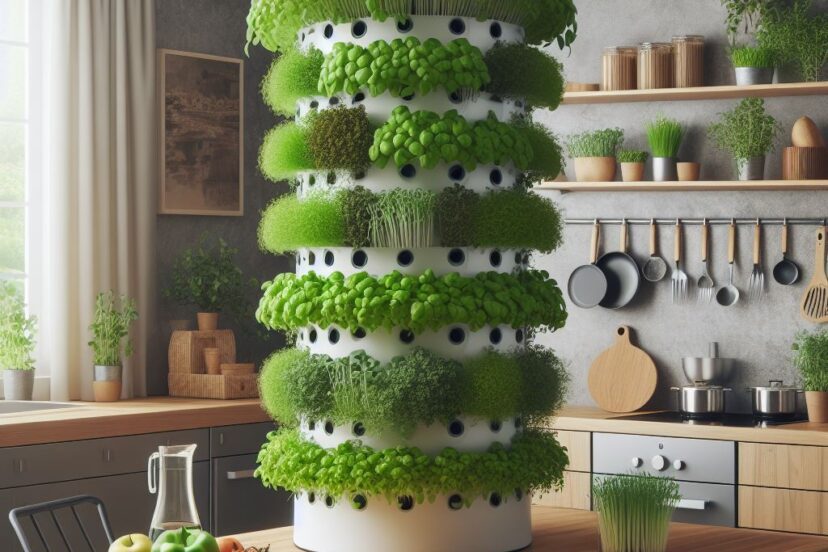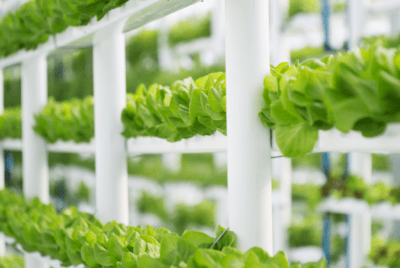Vertical Hydroponic System for Microgreens
"We may earn a commission for purchases made using our links. Please see our disclaimer to learn more."
Hello there, fellow gardening enthusiasts! If you’re anything like me, the joy of cultivating your own microgreens is unparalleled. In this article, I’ll be your guide through the exciting world of vertical hydroponic systems, focusing on their application for growing microgreens. Let’s dive in!
Introduction
Vertical hydroponic systems, a revolutionary approach to gardening, have gained immense popularity in recent years. Imagine a space-saving, water-efficient method of growing plants without soil, and you’re on the right track. These systems, often associated with terms like vertical farming and gardening, provide an innovative solution for urban dwellers and gardening aficionados alike.
Benefits of Vertical Hydroponic Systems
Space Efficiency
One of the primary advantages of vertical hydroponic systems is their space efficiency. Traditional gardening requires ample horizontal space, a luxury many urban dwellers lack. With vertical hydroponics, you can maximize your growing area, making it ideal for microgreens and other compact plants.
Water Conservation
Vertical hydroponic systems are designed with water conservation in mind. The recirculating nature of these systems ensures minimal water wastage, making them environmentally friendly and cost-effective in the long run.
Enhanced Nutrient Absorption
Plants grown in vertical hydroponic systems experience enhanced nutrient absorption. The controlled environment allows for optimal nutrient delivery, fostering healthier and faster growth.
Components of a Vertical Hydroponic System
Understanding the key components of vertical hydroponic systems is crucial for successful cultivation.
Hydroponic Towers
Hydroponic towers are vertical structures that house multiple planting pockets. These towers allow for a high density of plants in a compact space, making them perfect for microgreens.
Vertical Nutrient Film Technique (VNFT)
VNFT involves a thin film of nutrient-rich water flowing over plant roots. This technique is well-suited for vertical systems, providing a constant supply of nutrients to your crops.
Tower Gardens
Tower gardens are vertical structures with multiple tiers for planting. They often utilize aeroponic or hydroponic methods, offering flexibility for different crops.
Vertical Aquaponics
Combining aquaculture and hydroponics, vertical aquaponic systems use fish waste to fertilize plants. This symbiotic relationship results in a more sustainable and nutrient-rich environment for your microgreens.
Green Walls
Green walls, or living walls, are vertical installations of plants that can be incorporated into indoor or outdoor spaces. While not exclusively hydroponic, they contribute to the overall concept of vertical gardening.
Choosing the Right Vertical Hydroponic System
When selecting a vertical hydroponic system for growing microgreens, consider factors such as available space, budget, and the specific needs of your chosen plants. Additionally, stackable hydroponic systems offer flexibility for expansion and experimentation.
Top 10 Vertical Hydroponic System for Microgreens
Now, let’s explore the cream of the crop when it comes to best vertical hydroponic system for microgreens. Each of these systems has its unique features, and I’ve outlined the pros and cons to help you make an informed decision.
Lettuce Grow Farmstand: Stackable Sprouting Symphony for Salad Enthusiasts
Dreaming of harvest-ready salad greens within arm’s reach? The Lettuce Grow Farmstand offers a modular vertical haven (20″ x 16″ x 36″ per unit) for urban farmers seeking high yield and effortless cultivation. Stack these sleek units like leafy Legos, creating a custom green empire that fits your space and appetite. Pre-mixed nutrients take the guesswork out of feeding your leafy delights, and automated watering minimizes maintenance for busy lives. Enjoy lettuce, spinach, arugula, and more bursting with flavor in just 7-10 days.

✅ Pros:
- Modular design: Stack units vertically to maximize space and customize your garden size.
- High yield potential: Up to 12 heads of lettuce per level means salad dreams come true.
- Pre-mixed nutrients: No messy mixing, just add water and let the greens flourish.
- Automated watering: Enjoy low-maintenance microgreen magic with minimal refills.
- Diverse plant options: Experiment with a variety of leafy delights and even herbs.
❌ Cons:
- Requires assembly: Initial setup involves stacking and connecting units.
- Larger footprint: Compared to some compact systems, the Farmstand needs dedicated space.
- Subscription model for nutrients: Ongoing cost for pre-mixed nutrients.
- Limited plant variety: Compared to individual seed selection.
Overall, the Lettuce Grow Farmstand is a dream come true for salad-loving urbanites seeking a high-yielding and convenient hydroponic system. Its modular design, automated features, and pre-mixed nutrients make it ideal for maximizing space and minimizing effort. However, the assembly requirement, larger footprint, and subscription model might not appeal to everyone. Consider your budget, space constraints, and preference for pre-mixed nutrients before diving into this stackable sprouting symphony.
Gardyn Home Kit 3.0: Tech-Savvy Sprouting Sanctuary for Plant Parents
Craving an automated haven for your leafy dreams? The Gardyn Home Kit 3.0 (20″ x 20″ x 18″) blends sleek design with high-tech features, catering to the plant parent seeking a sophisticated and streamlined hydroponic experience. This modular marvel boasts 12 pre-loaded pods, ready to nourish basil, dill, cilantro, and a wide variety of herbs and microgreens in just 7-10 days. Automated watering and lighting control take the guesswork out of nurturing, and the dedicated app grants remote monitoring and adjustments, letting you tend to your leafy kingdom from anywhere.

✅ Pros:
- Automated watering and lighting: Effortless cultivation for busy lives.
- App control: Monitor and adjust settings remotely for ultimate convenience.
- Large capacity: 12 pods offer ample space for diverse culinary aspirations.
- Diverse plant options: Experiment with herbs, microgreens, and even salad mixes.
- Sleek design: Enhances any kitchen or living space with its modern aesthetic.
❌ Cons:
- Expensive: The initial cost is significantly higher than most other systems.
- Large footprint: Requires dedicated counter space compared to compact options.
- Complex setup with initial calibration: Can feel overwhelming for complete beginners.
- Limited customization: Pre-loaded pods restrict seed selection.
Overall, the Gardyn Home Kit 3.0 is a technological masterpiece for tech-savvy plant parents seeking automation and convenience. Its sleek design, diverse plant options, and remote control features make it a joy to own and use. However, the high initial cost, larger footprint, and complex setup might not be ideal for everyone, especially beginners. Consider your budget, space constraints, and comfort level with technology before diving into this automated sprouting sanctuary.
Nutraponics Hydroponics Tower: Modular Oasis for Urban Foodies
Seeking to harvest fresh, healthy food year-round in the smallest of spaces? The Nutraponics Hydroponics Tower (18″ x 18″ base, adjustable height) offers a vertical playground for your inner urban farmer. This modular marvel allows you to stack up to 48 plant levels, cultivating leafy greens, herbs, fruits, and even small vegetables with minimal effort. Its automated watering and nutrient delivery system takes the guesswork out of plant care, while powerful LED lights promote rapid growth. Think delicious microgreens in 7-10 days and herbs ready for snipping within weeks.
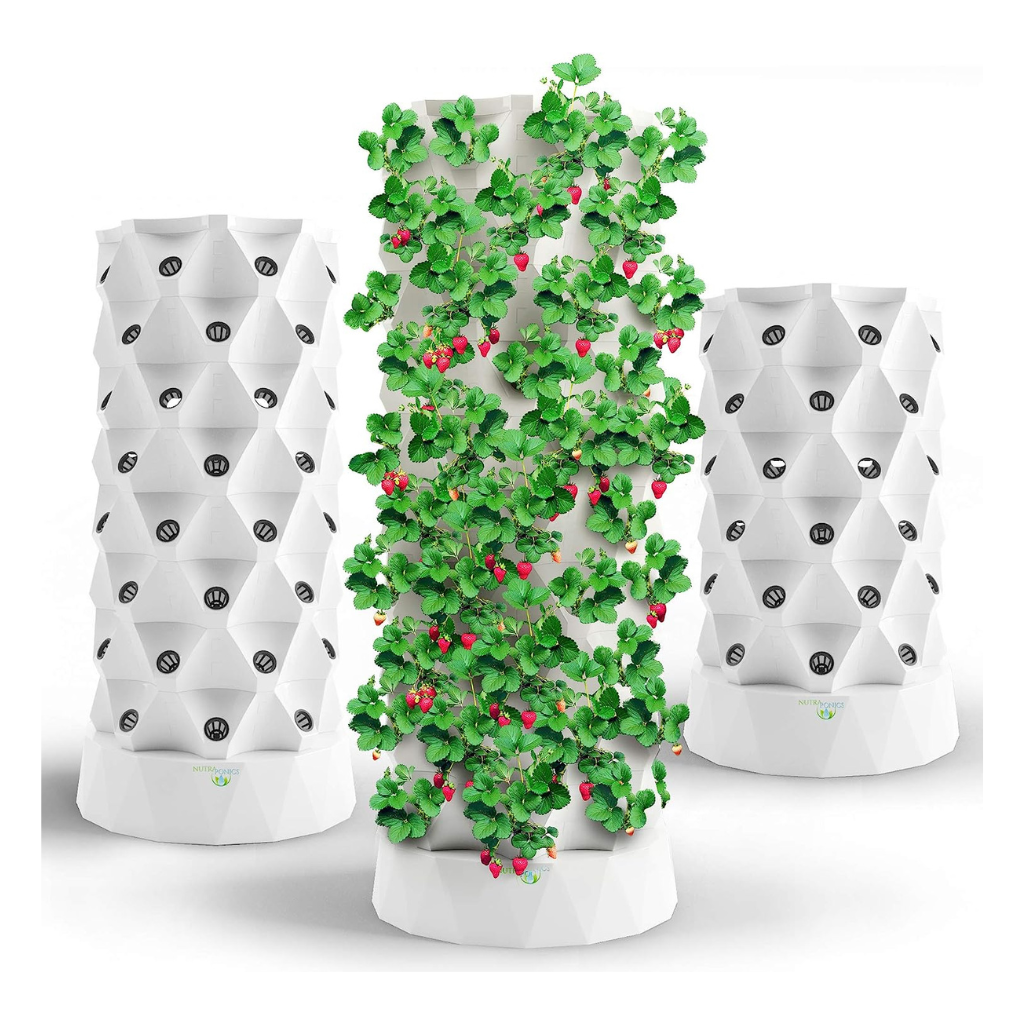
✅ Pros:
- Space-saving design: Stackable modules maximize vertical space even in cramped apartments.
- High yield potential: Up to 48 plant levels mean a bounty of homegrown goodness.
- Automated features: Effortless watering and nutrient delivery for busy lives.
- Fast-growing: Enjoy fresh microgreens and herbs in weeks.
- Energy-efficient LEDs: Powerful yet sustainable light for optimal plant growth.
❌ Cons:
- High initial cost: Investment-heavy compared to some systems.
- Complex setup: Requires initial assembly and calibration.
- Limited water reservoir: Might require more frequent refills than larger systems.
- Limited plant variety compared to individual seed selection.
Overall, the Nutraponics Hydroponics Tower is a dream come true for space-conscious individuals and families seeking a high-yield, automated hydroponic solution. Its modular design, powerful features, and rapid growth potential make it a compelling choice for cultivating a vertical food forest at home. However, the high initial cost, complex setup, and potential for frequent refills might not be ideal for everyone. Consider your budget, technical skills, and preferred level of flexibility in plant selection before embarking on this stacked sprouting adventure.
The Aerospring 27-Plant: High Yield in Tight Spaces, with Trade-Offs
Dreaming of a microgreen bonanza without sacrificing floor space? Enter the Aerospring 27-Plant Vertical Hydroponics System. This compact tower packs a punch, promising to nurture a forest of up to 27 leafy greens, herbs, and even microgreens in its vertical embrace. Imagine snipping trays of vibrant pea shoots bursting with flavor, spicy radish microgreens adding a fiery kick to your salads, and sun-kissed sunflower sprouts topping your morning smoothie. With the Aerospring’s rapid growth and nutrient-rich mist, these tiny powerhouses can be ready for harvest within days, turning your kitchen counter into a microgreen wonderland. But is this high-tech haven the perfect sprout palace for your tiny urban jungle? Let’s weigh the pros and cons
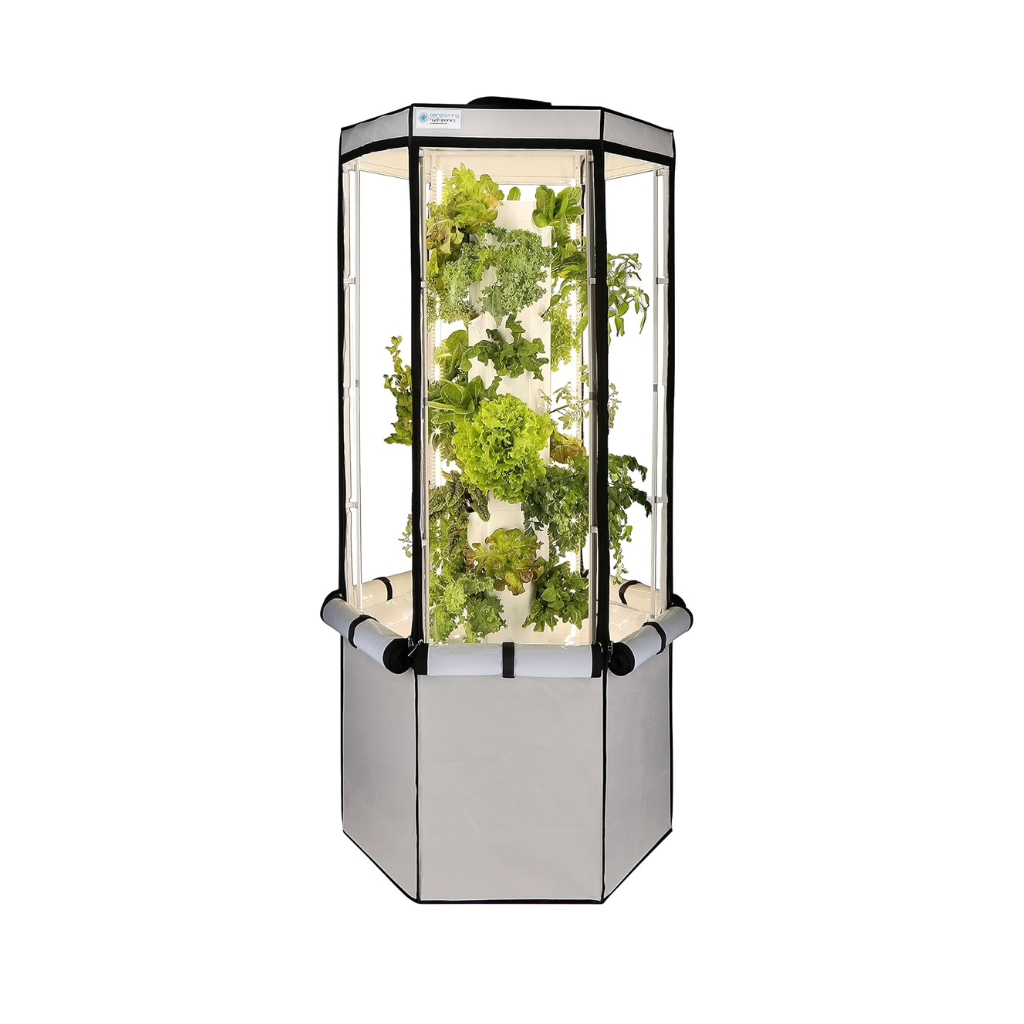
✅ Pros:
- Microgreen haven: This system shines for microgreens! Their rapid growth thrives in the aeroponic mist, potentially producing harvests within days.
- Space superhero: Say goodbye to sprawling gardens. This vertical wonder maximizes yield while minimizing footprint, perfect for urban balconies or cramped kitchens.
- Growth champion: Patented aeroponics delivers oxygen directly to roots, boosting growth compared to soil, giving you supercharged microgreens in no time.
- Water conservationist: Save up to 90% of water compared to soil gardening, making the Aerospring an eco-friendly ally for your green thumb.
- Tech-savvy simplicity: Automated watering and nutrient feeding make upkeep a breeze, leaving you more time to dream up microgreen recipes.
❌ Cons:
- Pricey palace: Be prepared for a higher initial investment compared to traditional gardening methods.
- Not for giants: Larger vegetables might struggle in this system, so stick to leafy greens, herbs, and micronutrient-packed microgreens.
- Learning curve lurks: While user-friendly, understanding hydroponics and maintaining optimal conditions for delicate microgreens requires some initial research.
- Power-hungry pump: Running the system relies on electricity, so ensure you have a dedicated outlet for this hungry growth machine.
- Separate sprout school: Similar to many hydroponic systems, germination happens outside the Aerospring, so plan for an additional setup for your aspiring microgreen seeds.
The Aerospring 27-Plant is a game-changer for microgreen enthusiasts and space-conscious urban gardeners. Its high yield, ease of use, and water efficiency make it a compelling option. However, the higher cost and learning curve require careful consideration. If you’re on board with the investment and enjoy microgreen experimentation, this system can be your ticket to a vibrant, delicious harvest. For budget-conscious beginners or those craving larger vegetables, alternative options might be more suitable.
The EXO Garden: Compact Convenience with a Few Quirks
Craving microgreen magic without sacrificing kitchen counter real estate? The EXO Garden Hydroponic Growing System Vertical Tower might just be your urban gardening dream come true. This compact, countertop marvel promises to nurture up to 12 leafy greens, herbs, and even microgreens in its sleek cylindrical embrace. Imagine snipping trays of vibrant broccoli sprouts bursting with antioxidants, peppery arugula microgreens adding a zesty kick to your salad, and tangy mustard greens topping your morning toast. With the EXO Garden’s rapid growth and nutrient-rich mist, these tiny nutritional powerhouses can be ready for harvest within days, transforming your kitchen counter into a microgreen wonderland. But before you jump headfirst into this vertical venture, let’s delve into its pros and cons:
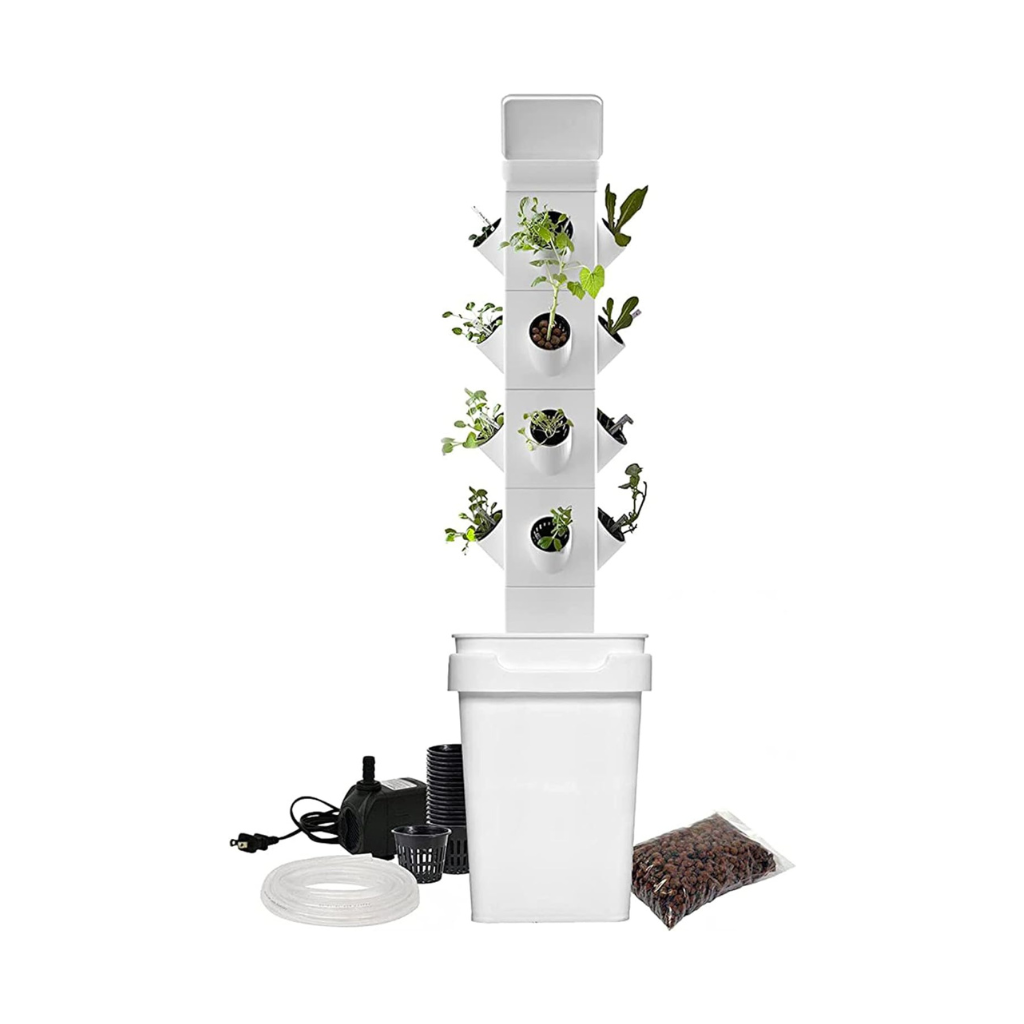
✅ Pros:
- Microgreen mecca: This system excels at microgreens! Their rapid growth thrives in the optimized environment, potentially producing harvests within days.
- Space-saving superhero: Say goodbye to sprawling gardens. This vertical wonder maximizes yield while minimizing footprint, perfect for cramped kitchens or urban balconies.
- Effortless efficiency: Automated watering and nutrient dosing take the guesswork out of plant care, making it ideal for busy gardening newbies.
- Fast-growing greens: The hydroponic system delivers nutrients directly to roots, potentially boosting growth compared to traditional soil methods.
- Eye-catching design: The sleek, modern tower doubles as a stylish kitchen accessory, adding a touch of green (and envy) to your counter.
❌ Cons:
- Price point pinch: Be prepared for a higher initial investment compared to basic gardening setups.
- Limited plant palette: This system works best for smaller plants like herbs, greens, and potentially miniature strawberries. Larger vegetables might struggle.
- Water dependence: While automated, the system relies on a consistent water supply to keep your plants thriving.
- Light limitations: The built-in LED light might not be sufficient for some light-loving plants, requiring additional adjustments.
- Pod-centric ecosystem: You’ll need to use the EXO Garden’s proprietary plant pods, limiting customization flexibility.
The EXO Garden is a convenient and stylish choice for space-conscious urban gardeners or those seeking an effortless entry into hydroponics, especially for microgreen enthusiasts. Its automated features and compact design make it ideal for busy individuals. However, the higher cost, limited plant variety, and reliance on pods might deter budget-minded or experienced gardeners. Weigh your priorities and plant preferences before taking the plunge.
Sjzx Hydroponics Growing System: Indoor Green Oasis or Techy Tower of Troubles?
Dreaming of a lush indoor garden without sacrificing floor space? The Sjzx Hydroponics Vertical Tower Garden 2.0 might be your urban gardening dream come true. This futuristic, seven-tier tower promises to skyrocket your plant game, nurturing up to 70 leafy greens, herbs, and even small fruits in its vertical embrace. But is this sleek spire the perfect oasis for your homegrown cravings? Let’s harvest its upsides and downsides:
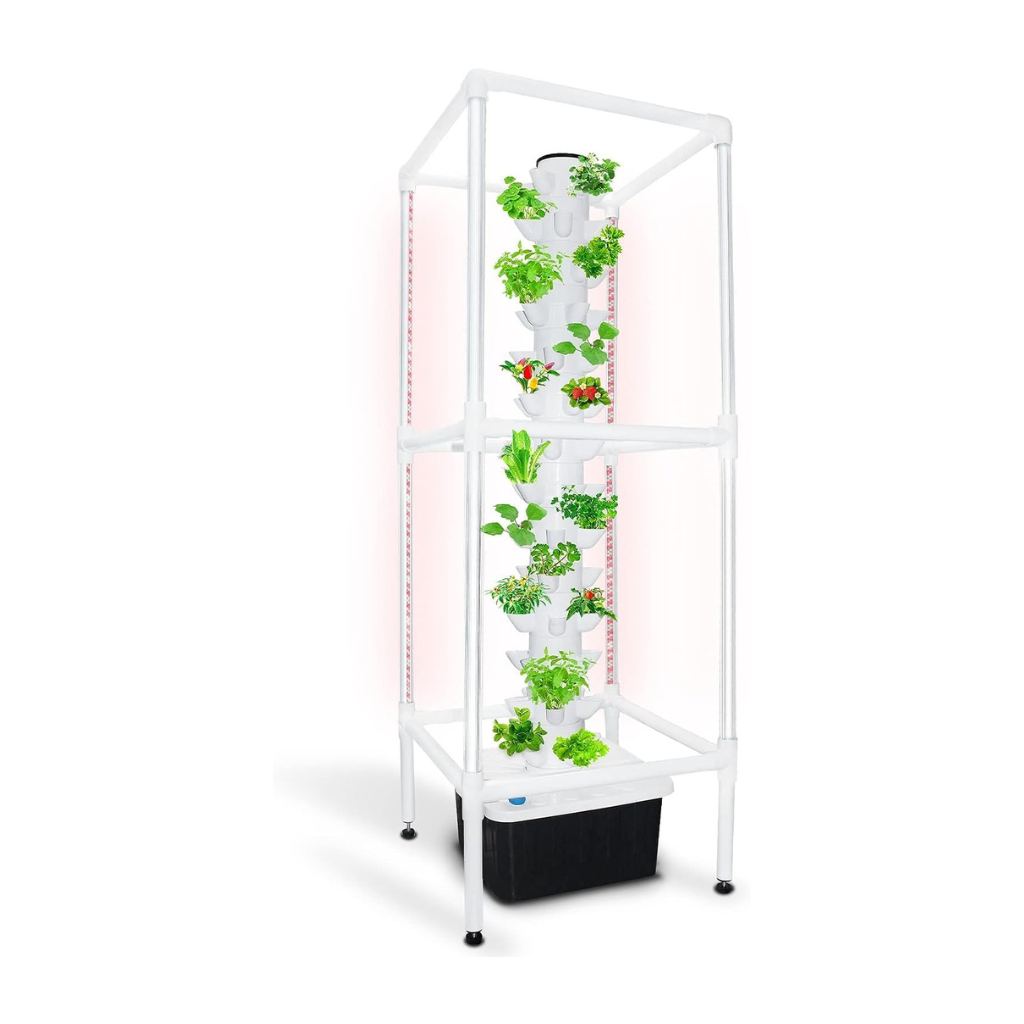
✅ Pros:
- Super Space Saver: This vertical tower optimizes small spaces, holding up to 70 plants in a footprint smaller than a chair.
- Effortless Automation: No more messy soil or daily watering! Timers manage the LED grow lights and automatic water circulation, simplifying plant care.
- Faster, Healthier Growth: Hydroponics delivers nutrients directly to roots, promoting rapid growth and potentially reducing pesticide needs.
- Wide Plant Variety: From leafy greens to strawberries, experiment with various herbs and vegetables, enjoying fresh produce all year round.
❌ Cons:
- Pricey palace: Be prepared for a high initial investment compared to traditional gardening methods.
- Learning curve lurks: While user-friendly, understanding hydro-speak and maintaining optimal conditions requires some initial research.
- Technical tango: This high-tech tower relies on electricity and a water pump, so ensure you have the outlets and maintenance know-how.
- No giants allowed: Large vegetables and sprawling vines might struggle in this vertically-challenged system. Stick to leafy delights and compact fruit wonders.
- Pod-powered ecosystem: You’ll need to use the Sjzx’s proprietary plant pods, limiting customization flexibility.
The Sjzx Hydroponics Vertical Tower Garden 2.0 is a powerful tool for space-conscious home gardeners who hunger for convenience and high yields. Its user-friendly automation, rapid growth potential, and sleek design make it a compelling option. However, the higher cost, technical aspects, and reliance on pods require careful consideration. If you’re on board with the investment and enjoy tech-infused greenery, this tower can be your ticket to a thriving indoor harvest. For budget-conscious beginners or those craving larger vegetables, alternative options might be more suitable
Mr. Stacky Smart Farm: Ditch the Sprinkler, Embrace Simplicity
Microgreen magic without the muddy mess? Enter the Mr. Stacky Smart Farm, your ticket to a thriving kitchen counter jungle brimming with flavor. Imagine snipping trays of vibrant pea shoots bursting with antioxidants, peppery arugula microgreens adding a zesty kick to your next dish, and tangy mustard greens topping your morning toast. This modular, self-watering tower promises to nurture up to 20 leafy greens, herbs, and microgreen powerhouses in its stacked, soil-based embrace. But before you embark on this vertical greenscaping adventure, let’s harvest its upsides and downsides to see if it aligns with your urban gardening dreams:
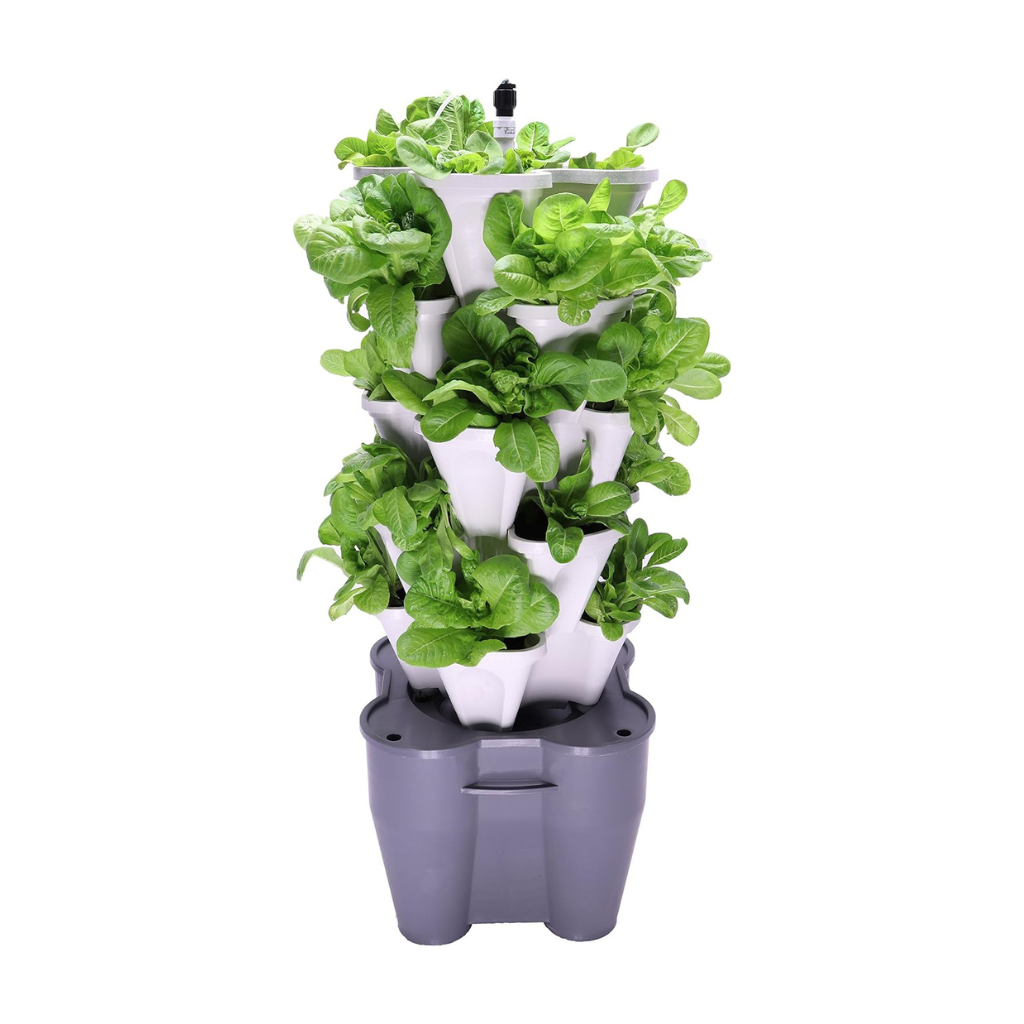
✅ Pros:
- Microgreen haven: This system shines for microgreens! Their rapid growth thrives in the organic environment, potentially producing harvests within days.
- Automatic watering paradise: Say goodbye to daily drenching! This clever system automatically waters and feeds your plants, ideal for busy bees and forgetful green thumbs.
- Organic goodness: Breathe easy knowing your greens are nurtured with organic nutrients and a soil-based medium.
- Modular magic: Expand your farm as your plant family grows! Add additional tiers to accommodate your sprouting ambitions.
- Easy-peasy assembly: Get growing in no time! This system boasts simple set-up and straightforward maintenance.
❌ Cons:
- Limited plant palette: Larger vegetables and sprawling vines might struggle in this stacked system. Stick to leafy delights, herbs, and microgreen wonders.
- Space considerations: While space-saving, each tier adds vertical height, so measure your available space before stacking.
- Manual nutrient mixing: Though automatic watering is a blessing, mixing the nutrient solution requires occasional attention.
- Cost per plant: While affordable overall, the price per plant increases with each additional tier, so consider your space and plant goals before scaling up.
- Slower for some: Growth might be slower compared to hydroponic systems for non-microgreen plants, requiring a bit more patience.
The Mr. Stacky Smart Farm is a convenient and user-friendly option for urban gardeners who prioritize organic goodness and minimal maintenance, especially microgreen enthusiasts. Its automatic watering, modular design, and soil-based approach make it ideal for busy individuals and organic enthusiasts. However, the slower growth for non-microgreens, limited plant variety beyond these tiny powerhouses, and space considerations might deter experienced gardeners or those craving larger harvests. Weigh your priorities and plant preferences before stacking!
HOPE INNOVATIONS Eden Tower Hydroponics System: Microgreen magic without messy soil
Yearning for a kitchen counter bursting with microgreen magic? Enter the HOPE INNOVATIONS Eden Tower Hydroponics System, your sleek portal to a hyper-growth indoor jungle. Imagine snipping trays of vibrant pea shoots packed with antioxidants, peppery arugula microgreens adding a zesty kick to your next dish, and tangy mustard greens topping your morning toast. This six-tier tower promises to skyrocket your leafy game, nurturing up to 36 greens, herbs, and microgreen powerhouses in its vertical embrace. But before you embark on this hydroponic adventure, let’s harvest its upsides and downsides to see if it aligns with your urban gardening dreams:
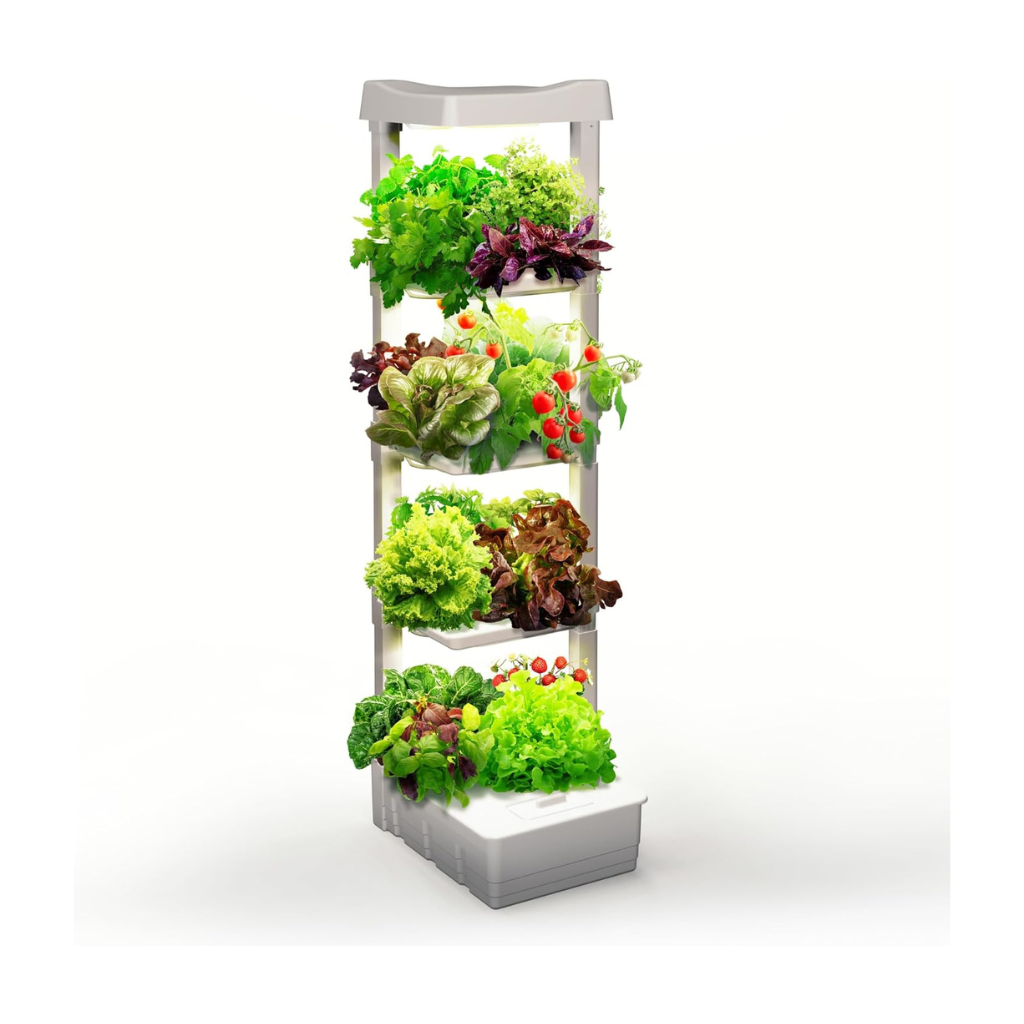
✅ Pros:
- Microgreen Mecca: This system shines for microgreens! Their rapid growth thrives in the optimized environment, potentially producing harvests within days.
- Growth on Steroids: Ditch the slow-pokes! Hydroponics delivers nutrients directly to roots, potentially doubling growth compared to soil, meaning faster microgreen bounty and more frequent trips to your vertical salad bar.
- Vertical Veggie Wonderland: Maximize yield with minimal footprint. This six-tier wonder packs a punch, perfect for cramped kitchens or urban balconies.
- Effortless Efficiency: Say goodbye to watering woes! The system automatically feeds and hydrates your plants, ideal for busy bees and forgetful green thumbs.
- Customizable Oasis: Tailor your tower to your taste buds! The modular design lets you adjust spacing and add accessories like targeted grow lights or misters for optimal microgreen conditions.
❌ Cons:
- Pricey Palace: Be prepared for a higher initial investment compared to traditional gardening methods.
- Learning Curve Lurks: While user-friendly, understanding hydro-speak and maintaining optimal conditions for microgreens requires some initial research.
- Technical Tango: This high-tech tower relies on electricity and a water pump, so ensure you have the outlets and maintenance know-how.
- Limited Plant Palette: Large vegetables and sprawling vines might struggle in this vertically-challenged system. Stick to leafy delights, herbs, and microgreen wonders.
- Pod-Powered Ecosystem: You’ll need to use the HOPE INNOVATIONS proprietary plant pods, limiting customization flexibility.
The HOPE INNOVATIONS Eden Tower is a powerful tool for space-conscious home gardeners who crave convenience and high yields, especially microgreen enthusiasts. Its user-friendly automation, rapid growth potential, and sleek design make it a compelling option. However, the higher cost, technical aspects, and reliance on pods require careful consideration. If you’re on board with the investment and enjoy tech-infused greenery, this tower can be your ticket to a thriving indoor microgreen wonderland. For budget-conscious beginners or those craving larger vegetables, alternative options might be more suitable.
Nutraponics Vertical Hydroponic System (Pro Shelf): Indoor Microgreen Oasis
Elevate your indoor gardening experience with the Nutraponics Hydroponics System, a cutting-edge solution tailored for microgreen enthusiasts. Whether you’re a seasoned gardener or a hobbyist, this Pro Shelf-sized hydroponic marvel, featuring 72 planters and 82 seeding sites, is designed to bring the joys of cultivating fresh, nutrient-packed microgreens right into the heart of your home. Its intelligent system integrates automated LED grow lights and smart technology, enabling you to effortlessly tailor lighting modes and water cycles to suit your microgreens’ specific needs. The result is a hassle-free, compact, and efficient microgreen haven that optimizes conditions for accelerated growth, ensuring your harvest is not only abundant but also rich in natural antioxidants and essential nutrients. This system makes microgreen cultivation a breeze, transforming your indoor space into a thriving microcosm of health and flavor.

✅ Pros:
- Microgreen haven: This system shines for microgreens! Their rapid growth thrives in the optimized environment, potentially producing harvests within days.
- Growth on steroids: Ditch the slowpokes! Hydroponics delivers nutrients directly to roots, potentially doubling growth compared to soil, meaning faster microgreen bounty and more frequent trips to your vertical salad bar.
- Vertical veggie wonderland: Maximize yield with minimal footprint. This seven-tier spire packs a punch, perfect for cramped kitchens or urban balconies.
- Automated oasis: Say goodbye to watering woes! The system automatically feeds and hydrates your plants, ideal for busy bees and forgetful green thumbs.
- Smart lighting system: Adjustable LED lights cater to various plant needs, ensuring optimal photosynthesis and thriving flora, including microgreens.
❌ Cons:
- Pricey palace: Be prepared for a significant initial investment compared to traditional gardening methods.
- Technical tango: This high-tech tower relies on electricity and a water pump, so ensure you have the outlets and maintenance know-how.
- Limited plant palette: Large vegetables and sprawling vines might struggle in this vertically-challenged system. Stick to leafy delights, herbs, and compact fruits.
- Learning curve lurks: While user-friendly, understanding hydro-speak and maintaining optimal conditions for microgreens requires some initial research.
- Pod-powered ecosystem: You’ll need to use the Nutraponics’ proprietary plant pods, limiting customization flexibility.
Overall, the Nutraponics Vertical Hydroponic System is a game-changer for microgreen enthusiasts, offering a seamless indoor cultivation experience. Tailored for efficiency and ease, the Pro Shelf-sized system integrates automated LED grow lights and smart technology, allowing users to effortlessly create an optimal environment for microgreens. With 72 planters in just 1sqm, the system ensures a bountiful harvest of natural and nutrient-rich microgreens. While there’s an initial cost and a slight learning curve, the long-term benefits make it a worthwhile investment for those committed to sustainable and hassle-free indoor gardening. Nutraponics stands as a beacon for year-round microgreen cultivation.
ZXMT 40-Pot Hydroponics Tower: Embark on a Microgreen Adventure
If you’re yearning for a burst of vibrant microgreens right from your countertop, the ZXMT 40-Pot Hydroponics Tower could be the key to instantly satisfying your salad cravings. Picture yourself snipping trays of peppery arugula microgreens, adding a zesty kick with tangy mustard greens to your meals, and garnishing your morning smoothie with antioxidant-packed pea shoots. This four-tier tower is designed to nurture up to 40 plants, boasting 8 seeding spots perfect for cultivating a variety of microgreens, all without a speck of soil. Before delving into this hydroponic journey, let’s explore its advantages and disadvantages to determine if it aligns with your urban gardening aspirations:
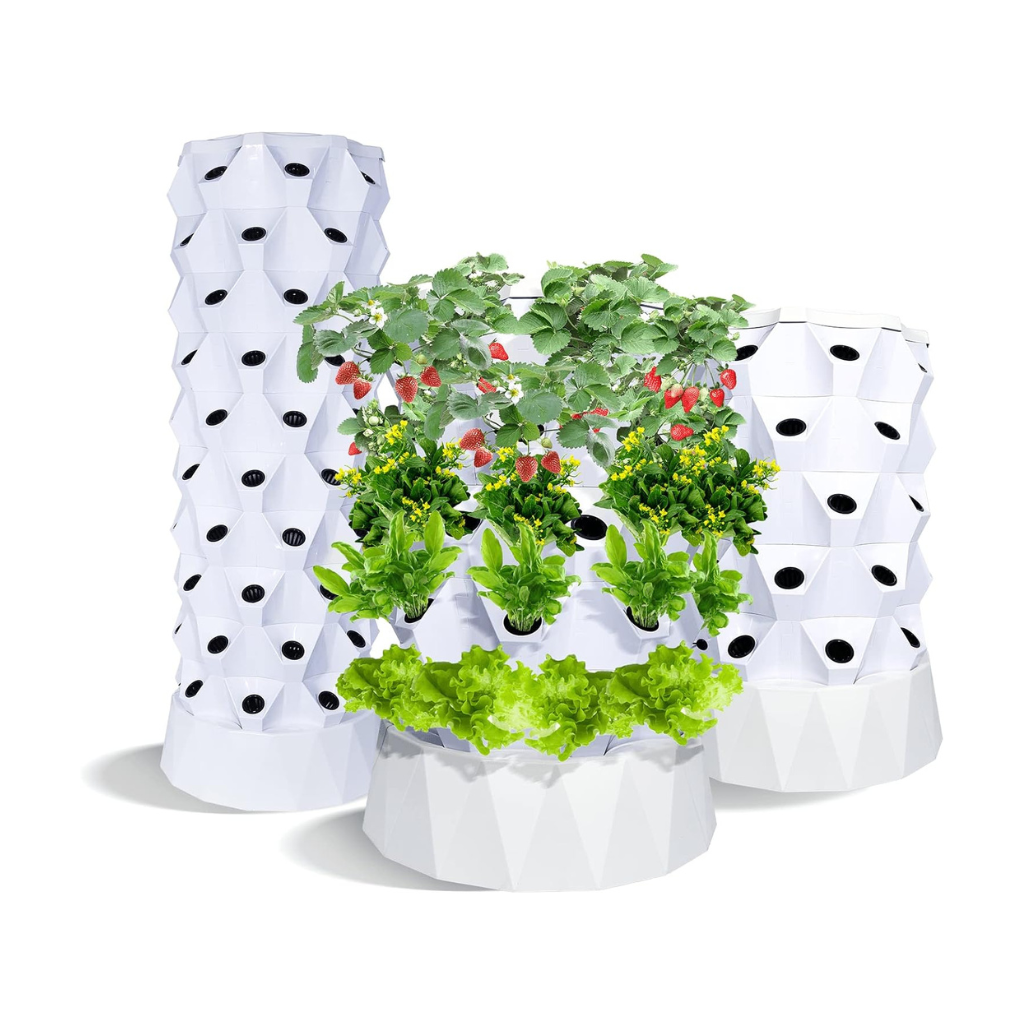
✅ Pros:
- Microgreen Marvel: This system excels in cultivating microgreens, with their rapid growth flourishing in the optimized environment, potentially yielding harvests within days.
- Speedy Sprouting: Bid farewell to slow growth! Hydroponics delivers nutrients directly to the roots, potentially doubling growth compared to soil, resulting in quicker microgreen bounty and more frequent visits to your vertical salad bar.
- Compact Convenience: Achieve maximum yield with minimal space. This four-tier wonder is a powerhouse, making it perfect for small kitchens or urban balconies.
- Automatic Oasis: Wave goodbye to watering worries! The system automatically provides the necessary nutrients and hydration to your plants, catering to busy individuals and forgetful green thumbs.
- Budget-Friendly Option: In comparison to other high-tech towers, the ZXMT offers an attractive price point for beginners.
❌ Cons:
- Limited Plant Palette: This vertically-oriented system may pose challenges for large vegetables and sprawling vines. It’s best suited for leafy delights, herbs, and compact fruits.
- Technical Tweaks: While user-friendly, understanding hydroponic terminology and maintaining optimal conditions requires some initial research.
- Learning Curve Lurks: Setting up and troubleshooting may demand tinkering for those new to hydroponic gardening.
- Pump Power: The system relies on electricity and a water pump, so ensure you have the necessary outlets and basic maintenance knowledge.
- Pod Potential: Although designed for soil-less growing, some users report success using the included net pots and their preferred planting medium.
The ZXMT 40-Pot Hydroponics Tower proves to be a formidable tool for space-conscious home gardeners seeking convenience and rapid microgreen harvests. Its affordability, automated features, and compact design make it an appealing choice for beginners. However, the limited plant variety, technical aspects, and learning curve warrant consideration. If you’re willing to engage in some tinkering and enjoy experimenting with microgreens, this tower could be your gateway to a flourishing indoor harvest. For seasoned gardeners or those desiring larger vegetables, exploring alternative options may be more suitable. Always conduct thorough research and align your priorities before embarking on the vertical gardening journey. Happy sprouting!
Maintenance Tips for a Vertical Hydroponic System
To ensure the longevity and productivity of your vertical hydroponic system, follow these essential maintenance tips:
- Regular Monitoring: Keep a close eye on nutrient levels, water pH, and plant health.
- Cleaning and Sanitizing: Prevent algae and bacterial growth by regularly cleaning system components.
- Troubleshooting Common Issues: Be proactive in identifying and resolving any issues promptly.
Vertical Farming and Vertical Gardening Trends
Vertical hydroponic systems play a pivotal role in current trends towards sustainable and space-efficient agriculture. From urban farms to community gardens, these systems are transforming the way we approach food cultivation.
Innovations in Vertical Hydroponics
As technology continues to advance, so do vertical hydroponics. Innovations such as automated monitoring systems, AI integration, and enhanced nutrient delivery methods are paving the way for even more efficient and productive gardening solutions.
Recommendations and Personal Favorites
In the realm of vertical hydroponic systems for microgreens, two standout options emerge as top picks. The Lettuce Grow Farmstand, known for its modular design and high-yield potential, offers a convenient and customizable solution. This system allows the cultivation of various greens with automated features, making it suitable for individuals with some gardening experience who prioritize efficiency and space optimization. On the other hand, the Gardyn Home Kit 3.0 caters to tech-savvy plant parents seeking a sophisticated and automated hydroponic experience. Despite its higher initial cost, its large capacity and diverse plant options make it a joy for users comfortable with advanced features.
For budget-conscious enthusiasts, the ZXMT 40-Pot Hydroponics Tower stands out as the most economical choice, focusing on microgreen cultivation and offering an attractive entry point into hydroponics for beginners. With automated features and a compact design, it suits those with limited space and a desire for hassle-free gardening. The Aerospring 27-Plant Vertical Hydroponics System strikes a balance between affordability and advanced features, making it an excellent choice for microgreen cultivation in tight spaces. Whether prioritizing convenience, advanced technology, or budget-friendly options, these top picks cater to a range of preferences within the vertical hydroponic gardening landscape.
Pros and Cons of Soilless Farming in Vertical Hydroponics
Pros:
- Precise Nutrient Control: Soilless farming allows growers to have meticulous control over the nutrient composition, ensuring optimal conditions for plant growth.
- Reduced Risk of Soil-Borne Diseases: Without soil, the risk of diseases transmitted through the soil is eliminated, promoting a healthier and disease-resistant crop.
- Efficient Water and Nutrient Use: Vertical hydroponic systems with soilless farming operate in closed-loop systems, recycling water and nutrients. This results in efficient resource utilization, reducing environmental impact and costs.
- Clean and Hygienic Environment: The absence of soil creates a cleaner cultivation environment, reducing the likelihood of pests and providing a more hygienic space for plant growth.
Cons:
- Initial Setup Costs: Adopting soilless farming in vertical hydroponics may incur higher initial setup costs, including the purchase of specialized equipment and nutrient solutions.
- Learning Curve for Beginners: Novice growers may face a learning curve in managing nutrient balance and system intricacies, requiring time and experimentation.
- Dependency on Artificial Lighting: In indoor settings, reliance on artificial lighting may be necessary, potentially leading to increased energy consumption and associated costs.
While these drawbacks are worth considering, the numerous advantages make soilless farming in vertical hydroponics an innovative and sustainable choice for modern agriculture.
Aeroponics and Vertical Hydroponics: A Winning Combination
Aeroponics, a method where plant roots are suspended in air and misted with nutrient-rich water, complements vertical hydroponics exceptionally well. This combination enhances nutrient absorption and promotes rapid growth, making it a winning strategy for microgreens.
Creating Green Spaces with Vertical Growing Systems
Beyond personal use, a vertical growing system can contribute to the creation of green spaces in urban environments. Community initiatives and urban beautification projects can leverage these systems to bring nature into the concrete jungle.
FAQs – Frequently Asked Questions
Q1: Can I grow other crops besides microgreens in a vertical hydroponic system?
Absolutely! Many vertical hydroponic systems are versatile and can accommodate various crops, from herbs to leafy greens.
Q2: How much space do I need for a vertical hydroponic system?
The space required depends on the system’s design and your chosen crops. Compact systems like the The EXO Garden are suitable for small spaces, while larger setups may need dedicated areas.
Q3: Are vertical hydroponic systems suitable for beginners?
Yes, several systems are beginner-friendly. Start with a system that matches your skill level and gradually experiment with more advanced setups.
Q4: Can I use natural sunlight for my vertical hydroponic system?
While natural sunlight is beneficial, many systems come with built-in LED lighting for consistent and controlled growth, especially in indoor environments.
Q5: How do I avoid overwatering my vertical hydroponic system?
Carefully monitor the water supply and nutrient levels. Most systems have user-friendly controls to adjust water flow and prevent overwatering.
Conclusion
In conclusion, embracing a vertical hydroponic system for microgreens opens up a world of possibilities for both seasoned gardeners and newcomers to the green scene. The top 10 systems highlighted here provide a diverse range of options, each with its unique advantages. As you embark on your vertical gardening journey, remember to choose a system that aligns with your goals, space, and preferences. Happy growing!

